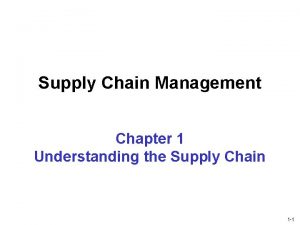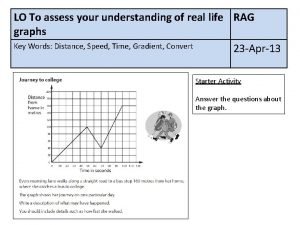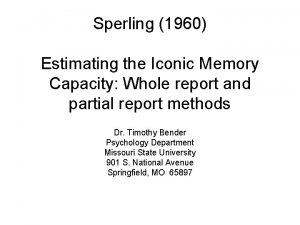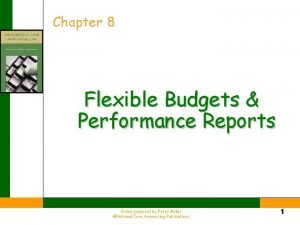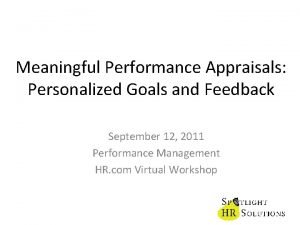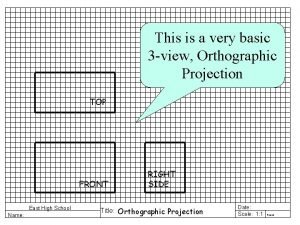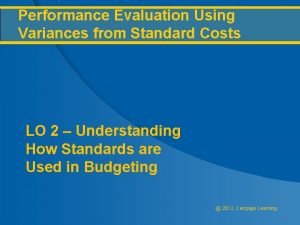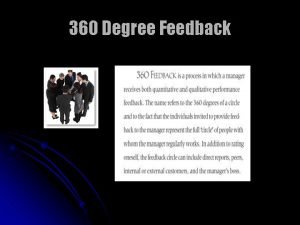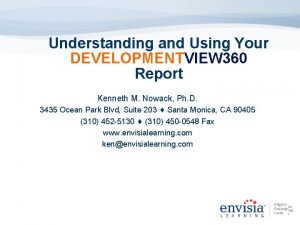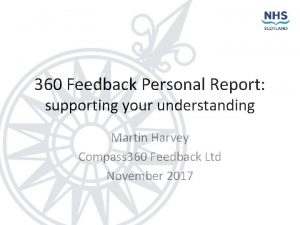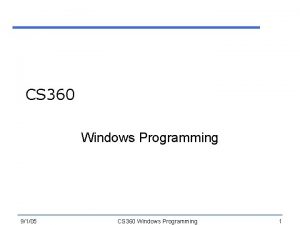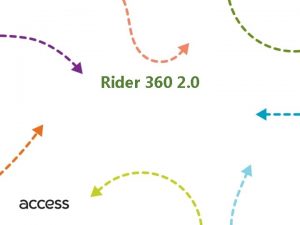Understanding and Using Your Performance View 360 Report



















































- Slides: 51

Understanding and Using Your Performance View 360 Report Kenneth M. Nowack, Ph. D. 3435 Ocean Park Blvd, Suite 203 Santa Monica, CA 90405 (310) 452 -5130 (310) 450 -0548 Fax www. envisialearning. com ken@envisialearning. com

Performance View 360 Presentation Outline § Performance View 360 Online Process § Understanding and Using Your Performance View 360 Results § Translating Awareness into Behavior Change: Talent Accelerator § Next Steps/Questions

Performance View 360 Online Process

“There are three things extremely hard: steel, a diamond and to know one’s self. ” Benjamin Franklin, 1750

Johari Window Public Blind Spot Private Unknown You Know About Me You Don’t Know About Me I know About Myself I Don’t know About Myself

PV 360 Welcome Screen

PV 360 Assessment

LV 360 Nomination Screen

Emotional Reactions to Feedback: GRASP Model Grin or Grimace Recognize or Reject Act or Accept Strategize & Partner Emotional Reaction Cognitive Reaction Commitment Reaction Behavioral Reaction

Interpreting Your Performance View 360 Feedback Report

Performance View 360 Task/Performance Management § Planning/Organizing § Project Management § Problem Solving § Decisiveness/Judgment Communication § Listening § Written Communication § Oral Presentation § Oral Communication § Two-Way Feedback Interpersonal § Collaboration § Interpersonal Sensitivity § Negotiation/Conflict § Team Support § Leadership/Influence

Performance View 360 Features § Measures 14 Competencies § 70 Behavioral Questions § Online Administration § Reliable and Valid Scales § Comprehensive Summary Feedback Report

Performance View 360 Report § Performance View 360 (PV 360) Competency Definitions and Conceptual Model § Self-Awareness/Social Awareness Comparison Graphs § PV 360 Overall Competency Graphs (self and other comparisons) § Most Frequent/Least Frequent Behavior Summary § Summary of Average Scores by Rater Category with Statistical Measure of Rater Agreement § Written Comments by Raters § Developmental Action Plan

Confidentiality of the 360 Feedback Process KEY POINTS § All raters are anonymous except for the “manager” § Online administration uses passwords to protect confidentiality (Internet administration) § No line or bar graphs are shown unless at least two raters respond in a rater category (anonymity protection) § The summary feedback report is shared only with the respondent and is intended for development purposes only § The respondent decides how much of the summary feedback report he/she wants to share with others

Self-Other Perceptions: What Are Others Really Rating? BOSS Performance Factors REPORTS Interpersonal Factors PEERS Future Leadership Potential

Feedback Report Components § Self-Other Comparisons § Graphical Comparisons “Johari Window” § Most and Least Frequently Observed Behaviors § Summary of Average Scores § Statistical Measure of Rater Agreement § Written Comments

Performance View 360 Invited Raters Page

Performance View 360 Awareness View Section KEY POINTS Performance View 360 provides a snapshot of self/social awareness in a series of graphs highlighting four areas: 1. 2. 3. 4. Potential Strengths (Low Self Ratings & High Other Ratings) Confirmed Strengths (High Self Ratings & High Other Ratings) Potential Development Areas (High Self Ratings & Low Other Ratings) Confirmed Development Areas (Low Self Ratings & Low Other Ratings)

Performance View 360 Awareness View

Performance View 360 Graphs Self-Other Perceptions KEY POINTS § Performance View 360 uses average scores based on the 1 to 5 effectiveness scale § The bar graphs summarize self and other perceptions on each of the separate LV 360 competencies § The legend to the right of the graph will summarize average score and number of raters for each category § Range of scores for each rater group are graphed

Performance View 360 Self-Other Perceptions

Performance View 360 Most Effective/Least Effective Section KEY POINTS § The “Most Effective” section and “Least Effective” section summarizes those competencies and behaviors that were most frequently/least frequently observed by various rater groups § The number in the first column corresponds to the average score for all raters providing feedback (1 to 5 scale) § The “Most Effective” should be considered as perceived strengths to leverage and build on § The “Least Effective” should be considered as possible behaviors to practice more frequently


Performance View 360 Behavior Summary KEY POINTS § Each Performance View 360 question is summarized and categorized in its appropriate competency § Average scores across all raters are reported for each competency and question § A statistical measure of rater agreement based on the standard deviation is reported as a percentage—a score less than 50% suggests that the raters providing feedback had enough disagreement to warrant a cautious interpretation of the average score reported (e. g. , raters had diverse perceptions and rated the participant quite differently on that question or competency)


Performance View 360 Written Comments Section KEY POINTS § Comments are randomly listed by all raters who volunteered to share written perceptions to two open-ended questions (perceptions of strengths and development areas) § Comments are provided verbatim from the online questionnaire—no editing § Some comments are specific, behavioral and constructive—others may be less useful or hard to understand § It is important to focus on themes that emerge, rather than, to dwell on any one individual comment


Performance View 360 Feedback Report Questions to Consider § Do I understand my Performance View 360 feedback report? § Does it seem accurate/valid? § Is the feedback similar or different for the different rater groups? § Are the areas perceived by others for development relevant to my current or future position? § Am I motivated to change?

Performance View 360: Next Steps § § § § Review your PV 360 feedback report Thank your invited raters and share something you learned from their feedback Identify specific developmental goals & draft a development plan Meet with your manager to discuss your plan Implement your development plan Track and monitor progress Re-assess Performance View 360 in 12 -18 months

“Our life transformation is in exact Charles proportion to Darwin the amount of truth we can take without running away. ” Vernon Howard

Necessary Ingredients for Behavior Change Mashihi, S. & Nowack, K. (2011). Clueless: Coaching People Who Just Don ’t Get It Enlighten • Assessment & Feedback Process (awareness of ideal self vs real self, strengths and potential development areas) • Readiness to change Encourage (clarification of motivations and beliefs) • Goal implementation intentions (measurable and specific) • Skill building Enable • Track & social support to reinforce learning • Relapse prevention training • Evaluation (knowledge acquisition, skill transfer, impact)

Momentor A Goal Setting, Reminder & Evaluation Tool

33

Selecting Development Areas Jump Right in to Select Your Goals or Use our Wizard

Using Our Wizard Step 1: Examining Your Feedback Report

Using Our Wizard Step 2: Deciding Which Competencies are Important

Using Our Wizard Step 3: Selecting Development Areas

Setting Development Goals Use our Suggestions or Select Your Own

Setting Development Goals Use our Suggestions or Select Your Own

From Goal Intentions to Implementation Action Items, Practice Plan, Goal Mentors & Goal Evaluation

Setting Development Goals--Action Items

Setting Development Goals--Action Items

Using the Resource Library Particular resources will be suggested in line with the goals you have created, however, you can click on the Resource Library Tab at anytime to explore the entire library You can access a wide selection of… • Articles • Audio • Books • On-the-job activities • Video • Websites/ blogs • Workshops/ Seminars Your resource library will be based on, and linked to, your specific competency model 43

Example Content from Our Resource Library

Goal Evaluation Getting Feedback on Your Goals

Momentor Goal Evaluation

Goal Evaluation

Momentor Reminders to Facilitate Behavior Change § § Momentor sends out a reminder email every week asking participants about their progress and reminding them of their goals Research suggests that implementation intentions coupled with reminders result in greater behavior change Sheer an, P. et al. (2005). The interplay between goal intentions and implementation intentions. Personality & Social Psychology Bulletin, 31, 87 -97 Prestwich, A. et al. (2010). Can implementation intentions and text messages promote brisk walking: A randomized trial. Health Psychology, 29 -40 -49.

Performance View 360 Follow Up § 33 percent of leaders who did not follow up with their managers, direct reports and peers about their 360 feedback results were rated as getting worse in evaluations about their performance after the leadership program Goldsmith, M. & Morgan, H. (2004). Leadership is a contact sport. Strategy + Business.

Learning and Reflection § § § What key learnings did I get from today’s presentation? (What have I heard? / What have I learned? ) How can I apply this new knowledge, information, or technique to a challenge at work? What specific actions am I committing to as a result of what I have learned?

360° Feedback Selected References § § § § Nowack, K. (2014). Taking the Sting Out of Feedback. Talent Development Magazine, 68, 50 -54. Nowack, K. & Mashihi, S. (2012). Evidence Based Answers to Ten Questions about Leveraging 360 Degree Feedback. Consulting Psychology Journal: Practice and Research, 64, 157– 182 Mashihi, S. & Nowack, K. (2011). Clueless: Coaching People Who Just Don’t Get It. Envisia Learning, Santa Monica, CA. Nowack, K. (2009). Leveraging Multirater Feedback to Facilitate Successful Behavioral Change. Consulting Psychology Journal: Practice and Research, 61, 280 -297 Nowack, K. (2006). Emotional Intelligence: Leaders Make a Difference. HR Trends, 17, 40 -42 Nowack, K. (1999). 360 -Degree feedback. In DG Langdon, KS Whiteside, & MM Mc. Kenna (Eds. ), Intervention: 50 Performance Technology Tools, San Francisco, Jossey-Bass, Inc. , pp. 34 -46. Nowack, K. , Hartley, G, & Bradley, W. (1999). Evaluating results of your 360 -degree feedback intervention. Training and Development, 53, 48 -53. Nowack, K. (1999). Manager View/360. In Fleenor, J. & Leslie, J. (Eds. ). Feedback to managers: A review and comparison of sixteen multi-rater feedback instruments (3 rd edition). Center for Creative Leadership, Greensboro, NC. , Wimer & Nowack (1998). 13 Common mistakes in implementing multi-rater systems. Training and Development, 52, 69 -79. Nowack, K. & Wimer, S. (1997). Coaching for human performance. Training and Development, 51, 2832. Nowack, K. (1997). Congruence between self and other ratings and assessment center performance. Journal of Social Behavior & Personality, 12, 145 -166 Nowack, K. (1994). The secrets of succession. Training & Development, 48, 49 -54 Nowack, K. (1993). 360 -degree feedback: The whole story. Training & Development, 47, 69 -72 Nowack, K. (1992). Self-assessment and rater-assessment as a dimension of management development. Human Resources Development Quarterly, 3, 141 -155.
 View in 360
View in 360 The ability to locate interpret and apply information
The ability to locate interpret and apply information Chapter 1 understanding your health and wellness
Chapter 1 understanding your health and wellness Chapter 1 understanding your health and wellness
Chapter 1 understanding your health and wellness Chapter 1 understanding health and wellness
Chapter 1 understanding health and wellness Chapter 1 understanding your health and wellness
Chapter 1 understanding your health and wellness Status progress report
Status progress report Give us your hungry your tired your poor
Give us your hungry your tired your poor Birds eye view angle
Birds eye view angle Simple view and complex view
Simple view and complex view Simple view and complex view
Simple view and complex view Simple view and complex view
Simple view and complex view Mvc partial view controller
Mvc partial view controller Supply chain cycle
Supply chain cycle Components of operating system
Components of operating system Separatist view and integration view
Separatist view and integration view Isometric and orthographic drawing
Isometric and orthographic drawing Understanding your stakeholders
Understanding your stakeholders Trust in the lord song
Trust in the lord song Lean not on your own understanding
Lean not on your own understanding Let's check your understanding
Let's check your understanding Understanding your business finances
Understanding your business finances Understanding your digital footprint
Understanding your digital footprint Miymaths
Miymaths Understanding your intuition
Understanding your intuition Real life graphs
Real life graphs Sperling 1960
Sperling 1960 Adsb performance report
Adsb performance report Flexible budgets and performance analysis
Flexible budgets and performance analysis Mark receives a score report detailing his performance
Mark receives a score report detailing his performance Supplier performance report excel
Supplier performance report excel Kari røsand
Kari røsand Performance levels
Performance levels Behaviorally anchored rating scale
Behaviorally anchored rating scale 2018 jcids manual
2018 jcids manual Top view is directly above the front view
Top view is directly above the front view Revolved section view
Revolved section view Revolved sectional view
Revolved sectional view What is full section
What is full section Elevation projection
Elevation projection Pictorial views drawn on isometric scale are called
Pictorial views drawn on isometric scale are called For the view create view instructor_info as
For the view create view instructor_info as Chest x-ray anatomy
Chest x-ray anatomy Multi view drawings
Multi view drawings Front view top view
Front view top view For the view create view instructor_info as
For the view create view instructor_info as Completing a report using mla quizlet
Completing a report using mla quizlet Performance testing mobile applications using loadrunner
Performance testing mobile applications using loadrunner Performance evaluation using variances from standard costs
Performance evaluation using variances from standard costs Drawing auxiliary view using center plane reference
Drawing auxiliary view using center plane reference Definition of ideal self
Definition of ideal self System.collections.generics
System.collections.generics













